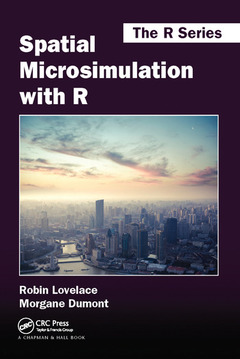Spatial Microsimulation with R Chapman & Hall/CRC The R Series
Auteurs : Lovelace Robin, Dumont Morgane

Generate and Analyze Multi-Level Data Spatial microsimulation involves the generation, analysis, and modeling of individual-level data allocated to geographical zones. Spatial Microsimulation with R is the first practical book to illustrate this approach in a modern statistical programming language.
Get Insight into Complex BehaviorsThe book progresses from the principles underlying population synthesis toward more complex issues such as household allocation and using the results of spatial microsimulation for agent-based modeling. This equips you with the skills needed to apply the techniques to real-world situations. The book demonstrates methods for population synthesis by combining individual and geographically aggregated datasets using the recent R packages ipfp and mipfp. This approach represents the "best of both worlds" in terms of spatial resolution and person-level detail, overcoming issues of data confidentiality and reproducibility.
Implement the Methods on Your Own DataFull of reproducible examples using code and data, the book is suitable for students and applied researchers in health, economics, transport, geography, and other fields that require individual-level data allocated to small geographic zones. By explaining how to use tools for modeling phenomena that vary over space, the book enhances your knowledge of complex systems and empowers you to provide evidence-based policy guidance.
Robin Lovelace is a University Academic Fellow at the University of Leeds specializing in methods of spatial data analysis and applied transport modeling. Creator of the stplanr package and a number of popular tutorials, he is an experienced R user, teacher, and developer. Robin uses open source software daily for spatial analysis, map making, statistics, and modeling. His current research focuses on online interactive mapping and modeling to provide the evidence base needed for a transition away from fossil fuels in the transport sector. Morgane Dumont is an applied mathematician currently undertaking a PhD at the University of Namur. She has a wealth of experience programming in R, Python, C, Fortran, and MATLAB®. Her research focuses on forecasting the health needs of the elderly in 2030 for Belgium. To achieve this aim, Morgane is developing a synthetic population for Belgium as an input to an agent-based model.
Date de parution : 07-2017
15.6x23.4 cm
Date de parution : 03-2016
15.6x23.4 cm
Thèmes de Spatial Microsimulation with R :
Mots-clés :
Spatial Microsimulation; Spatial Microdata; microdata; IPF Function; population; Spatial Microsimulation Model; synthesis; Population Synthesis; individual; Synthetic Spatial Microdata; level; Individual Level Dataset; data; Alternative Specific Constant; models; Biggest Decimal; dataset; IPF Algorithm; aggregate; Individual Level Data; synthetic; Constraint Variables; household allocation; ABM; Synthetic Population; R packages; Data Frame; Synthetic Households; Microsimulation Model; IPF; Combinatorial Optimisation Approaches; Integer Weight; Initial Weight Matrix; Average Income; Count Inhabitants; Residential Location Model; Discrete Choice Model



